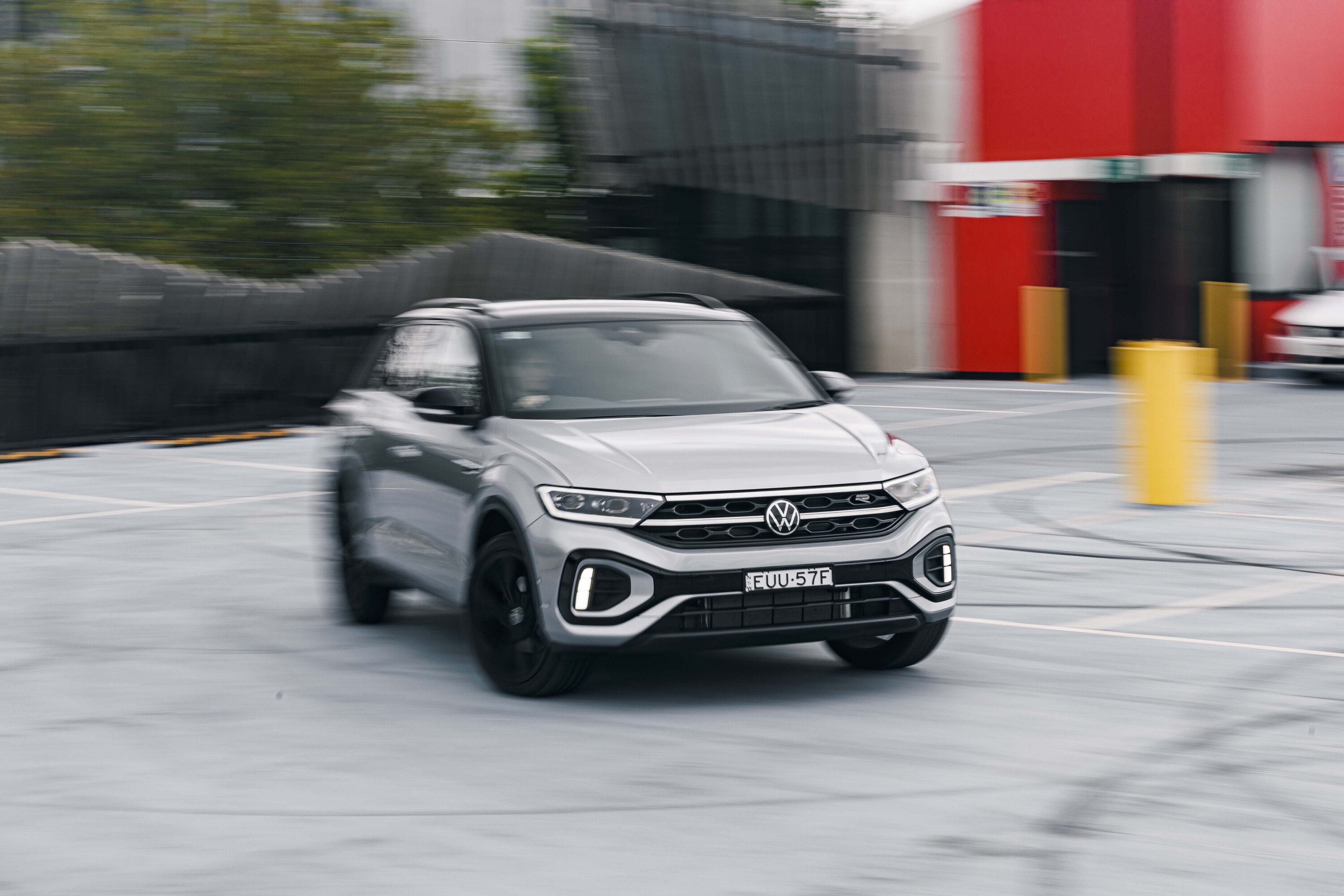Score breakdown
Things we like
- Excellent turbo powertrain
- Top-of-class dynamics
- Improved cabin presentation
Not so much
- Expensive to buy and maintain
- Touch-sensitive haptic controls
- Lacks head-up display, traffic sign recognition
The updated 2023 Volkswagen T-Roc small SUV arrived late last year.
Volkswagen Australia forecasts the T-Roc will be its top-selling car in 2023, a position traditionally held by the Golf and, more recently, the Tiguan, as both face supply constraints and small SUVs surge in popularity.
First launched here in 2020, the T-Roc slots between the light T-Cross and mid-size Tiguan, while the variant tested here – the 140TSI R-Line – is positioned between the 110TSI and R.
We were impressed with the T-Roc R-Line at its media launch last year, but it is now time to spend more time behind the wheel of Volkswagen’s middle child to see if it’s the right small SUV for you.

JUMP AHEAD
- How much is it, and what do you get?
- Where is this model in its lifecycle?
- How do rivals compare on value?
- Interior quality, comfort, space and storage
- Technology in the cabin
- What is it like to drive?
- How is it on fuel?
- How safe is it?
- Warranty and running costs
- VERDICT
- Specifications
How much is it, and what do you get?
| 2023 Volkswagen T-Roc 140TSI R-Line features | |
|---|---|
| 18-inch alloy wheels (Black Pack: 19-inch alloys) | LED headlights, tail-lights, and daytime running lamps |
| 8-inch infotainment system | Dual-zone climate control |
| Wireless or wired Apple CarPlay and Android Auto | Heated front seats |
| 12.3-inch digital instrument cluster | USB-C ports (2x front, 2x rear) |
| Satellite navigation | Adjustable dampers (Black Pack) |
The 2023 Volkswagen T-Roc 140TSI R-Line is priced at $47,090 before on-road costs, following a recent update.
As standard, the T-Roc features 18-inch alloy wheels, a six-speaker audio system, integrated satellite navigation, dual-zone climate control, LED lighting, cloth upholstery, front and rear parking sensors, rain-sensing wipers, and leather trim for the steering wheel and gear selector.
The aforementioned update sees the R-Line gain standard-fit equipment previously limited to the now-deleted Luxury Package, including Nappa leather upholstery, heated front seats, and an eight-way power-adjustable driver’s seat with two-position memory function.
Three option packages are available for the T-Roc R-Line, with two fitted to our test vehicle – and premium paint – pushing the price to $51,290 plus on-road costs.
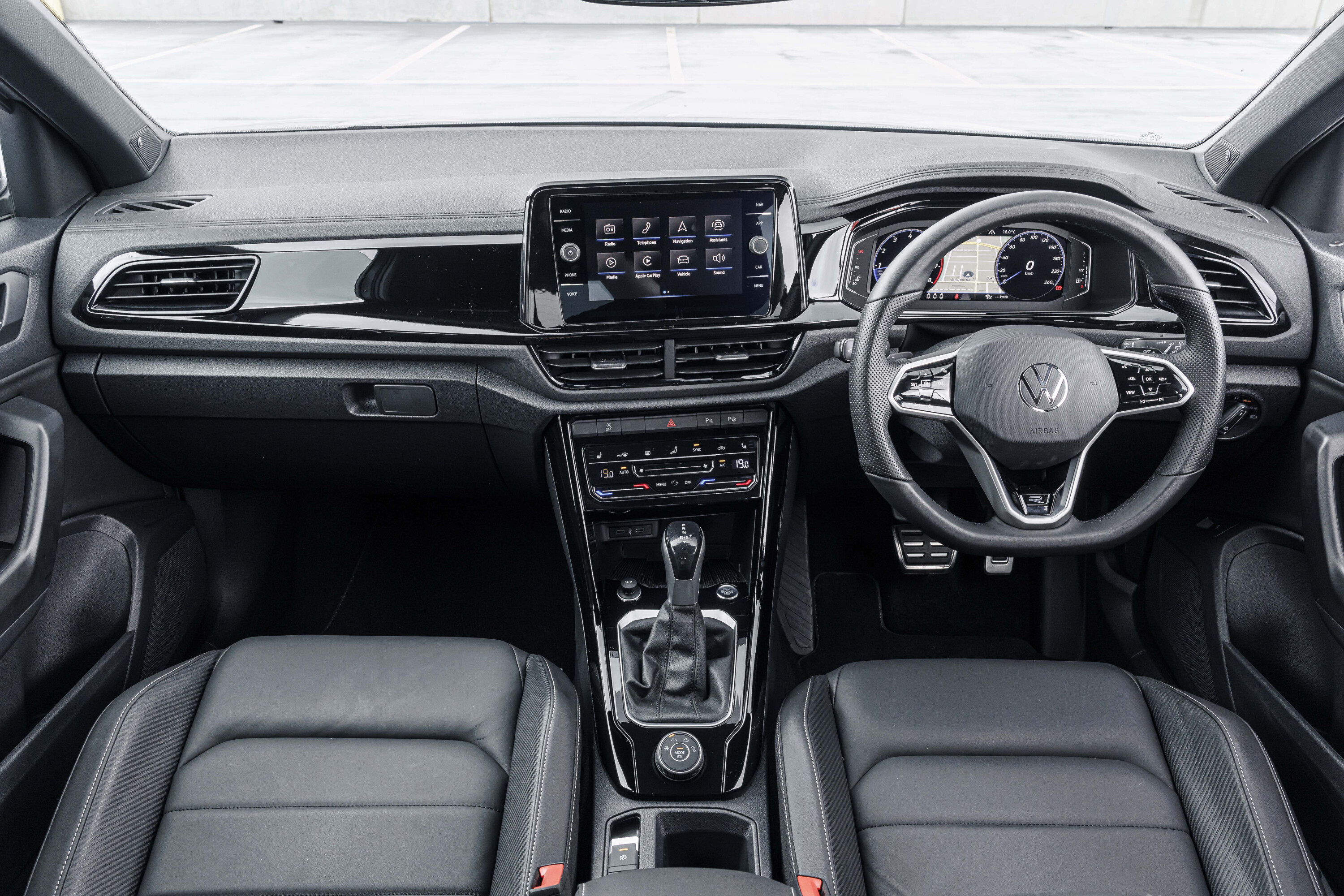
This comprises the Black Style package and an eight-speaker, 300-watt Beats audio system ($2900), an electric tailgate ($600), and pyrite silver metallic paint ($700).
As such, it borders close to $60,000 drive-away – not including the $2000 panoramic sunroof – which is a lot for a mainstream small SUV.
However, as you’ll discover, the overall package provides a compelling alternative to the likes of a similarly-priced, entry-level Audi Q3 and Mercedes-Benz GLA.

Early examples of the MY23 T-Roc Style and R-Line weren’t fitted with the requisite components for blind-spot monitoring and rear cross-traffic alert, nor the proactive occupant protection system to automatically shut the windows, tighten the seatbelts and apply the hazard lights if a potential accident is detected.
However, the updated T-Roc has returned to full specification, with blind-spot monitoring and rear cross-traffic alert – though proactive occupant protection remains absent.
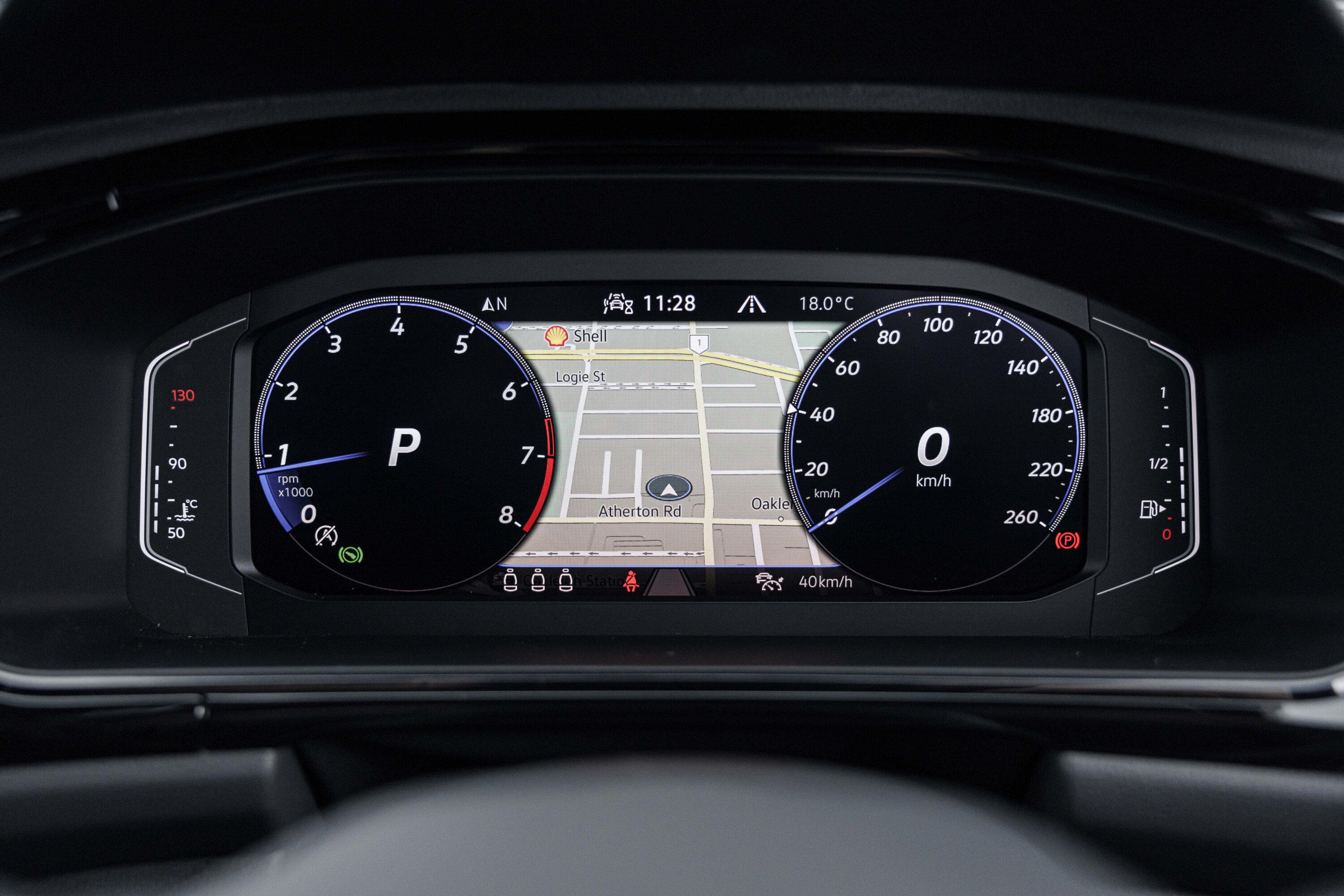
Where is this model in its lifecycle?
The Volkswagen T-Roc debuted in Europe in 2017, but homologation-related delays led to a mid-2020 Australian launch.
A mid-life facelift was introduced in 2022, meaning the current T-Roc still has a few years ahead before it is replaced by a second-generation model.
Due in 2026, the next-generation T-Roc is expected to be Volkswagen’s last all-new internal-combustion vehicle.
It should ride on Volkswagen’s updated MQB Evo platform – found underneath the eighth-generation Golf and the forthcoming Tiguan and Passat – with mild-hybrid and plug-in hybrid technology likely.
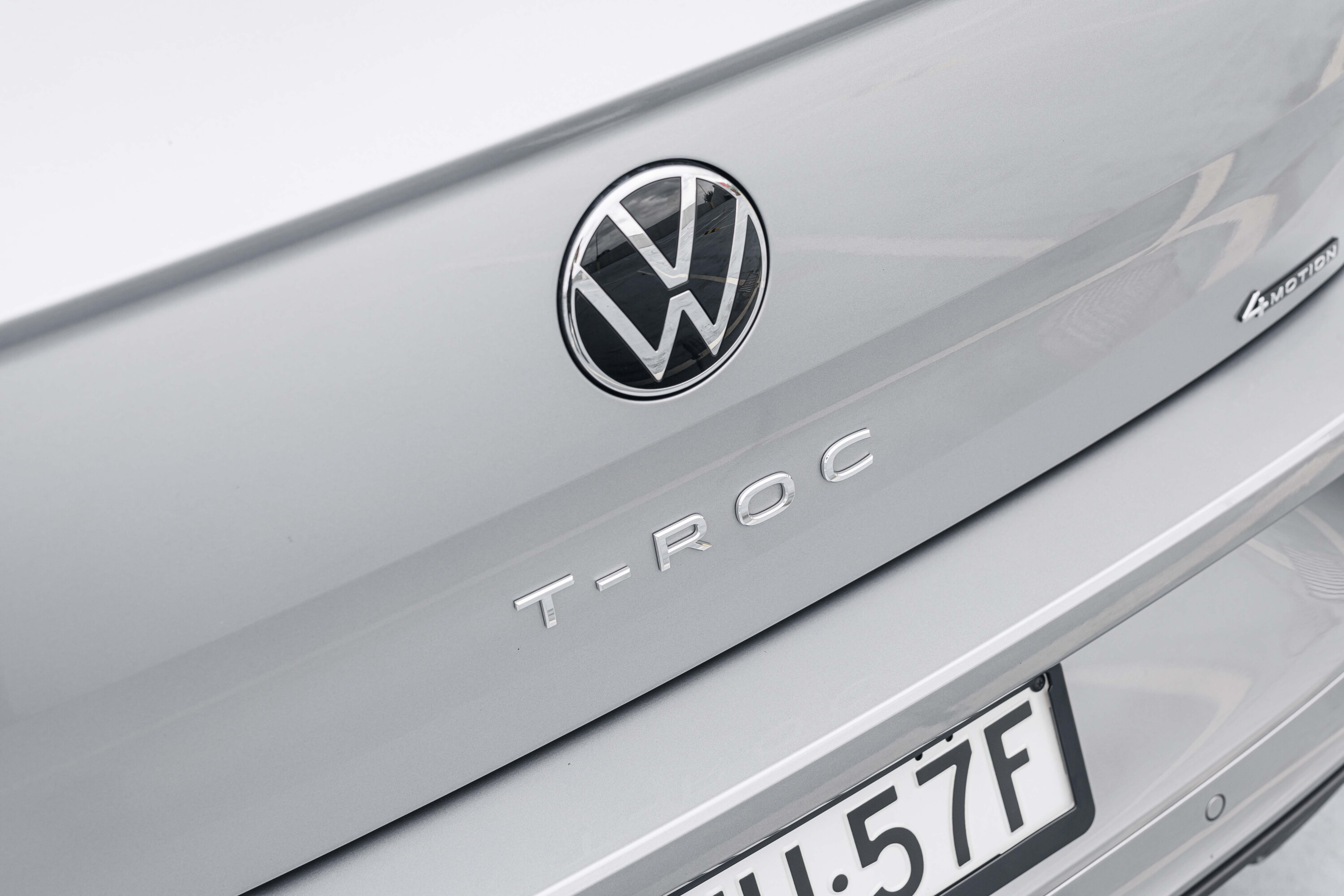
How do rivals compare on value?
The main competitors for the Volkswagen T-Roc in Australia are vehicles from Toyota, Mazda, and VW’s sister brand, Cupra.
Among these are the Toyota Corolla Cross, the Cupra Formentor, and the popular Mazda CX-30.
However, with the ability to specify a T-Roc R-Line beyond $60,000 drive-away – and the presence of an even dearer, hotted-up R – it also faces established premium rivals, such as the Volvo XC40, Audi Q3, Mercedes-Benz GLA and BMW X1.
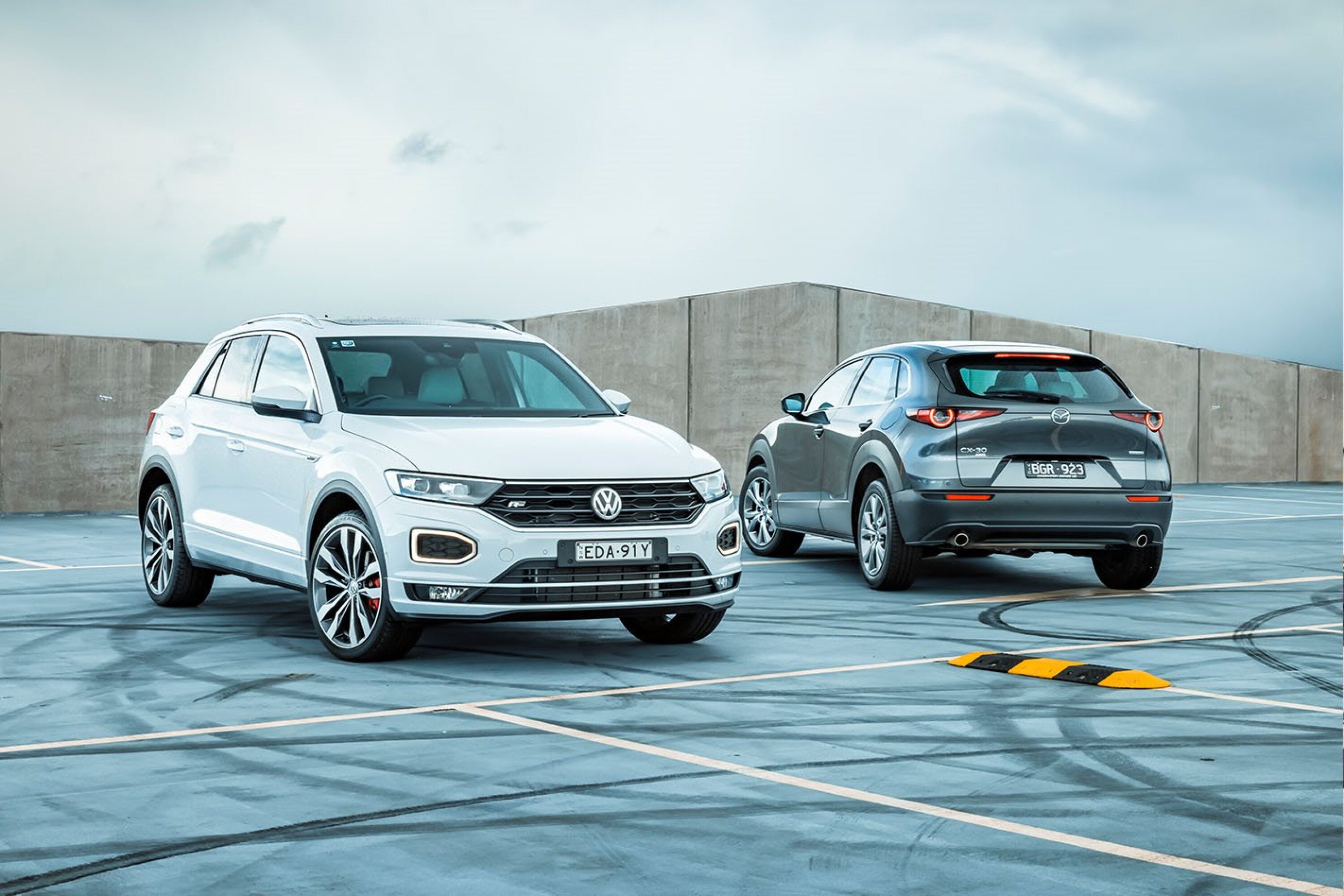
Unlike the CX-30 and Corolla Cross, the T-Roc isn’t available with traffic sign recognition, a 360-degree camera system or a larger infotainment system.
However, apart from those omissions, it is a well-specced small SUV that mostly ticks all the right boxes.
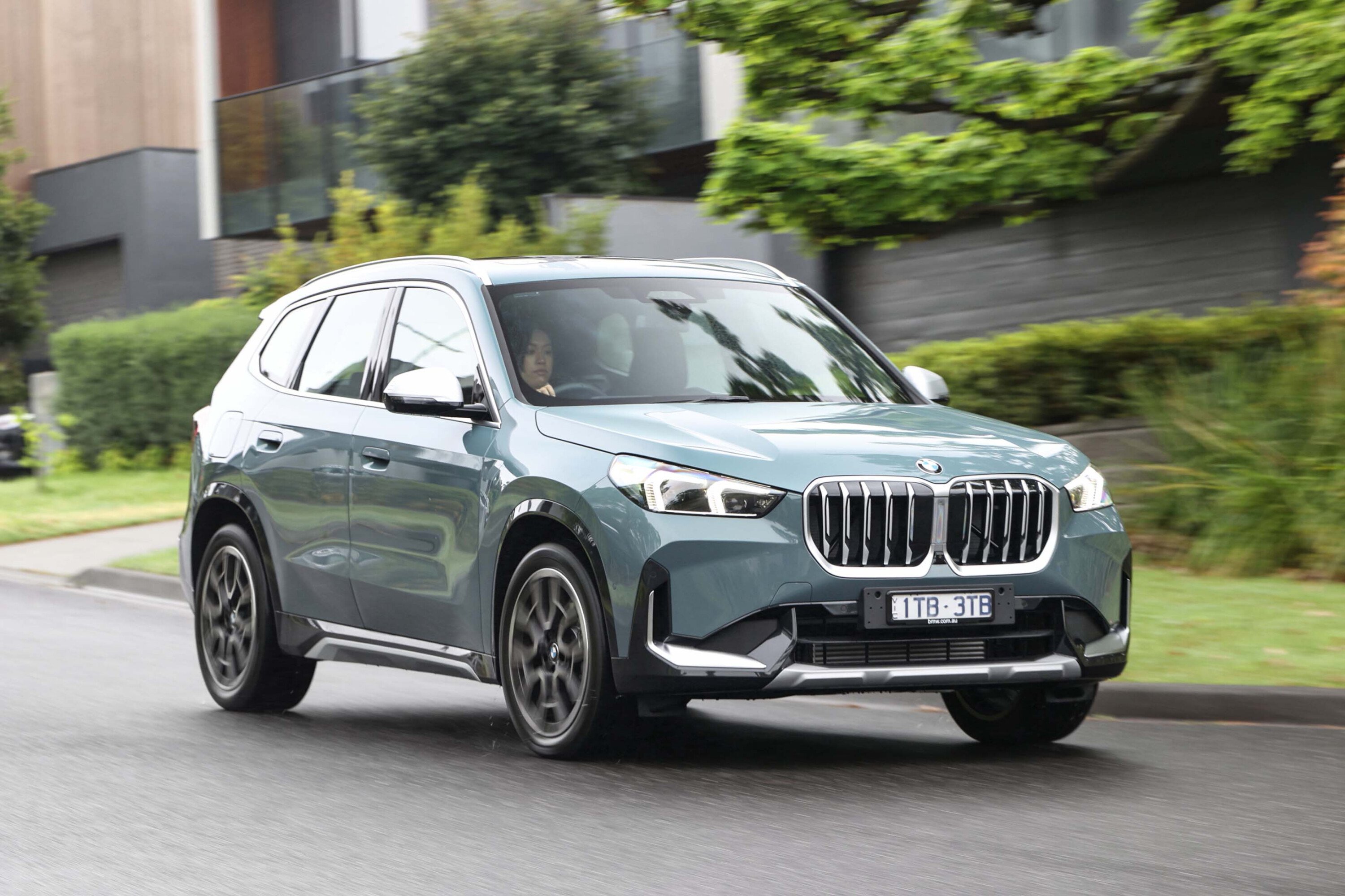
Interior quality, comfort, space and storage
The updated T-Roc’s cabin is a step up from previously but it still doesn’t match the quality of a Golf or Tiguan.
Following customer and media feedback, Volkswagen added a soft-touch dashboard and floating infotainment system, and all models have sportier-looking seats.
However, there are still enough hard plastics that feel closer to those of a Kia Seltos, rather than the Mazda CX-30 or Peugeot 2008 – let alone base versions of the luxury small SUVs the T-Roc overlaps on price.
Our test vehicle was fitted with the now-standard Nappa leather, which helps to improve comfort with tighter bolsters and front-seat heating for cold days. It also features eight-way power adjustment and two-position memory for the driver’s seat, though you won’t find ventilated seats on any T-Roc.
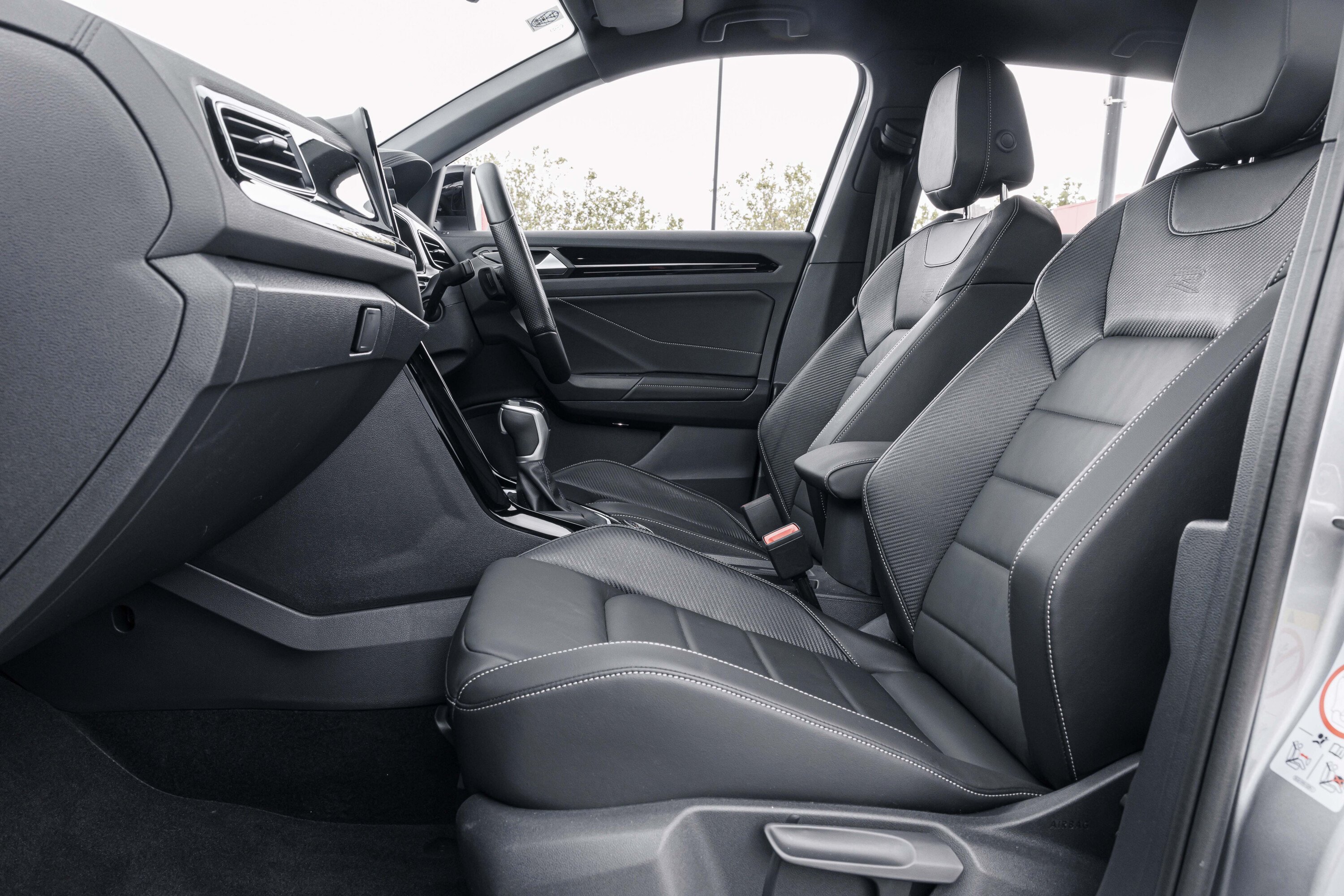
It has generous storage for a small SUV, with deep door bins, a large glovebox, and a wireless charger ahead of the gear selector that can double as a storage nook for smaller items.
Second-row room is tight, but there’s still enough room in the outer-rear seats for average-sized adults – this writer had no issue sitting behind his own driving position at 182cm tall – and even more space for children, with outboard ISOFIX points and top-tether anchors for all three positions.
However, it would be a struggle to fit three people abreast in the T-Roc, with a narrow bench attributable to the small body and a tall transmission tunnel hindering passengers in the centre seat.
Rear passengers are looked after with air vents, two USB-C ports, a centre armrest with cup holders, seat pouches, and drink holders in the doors.
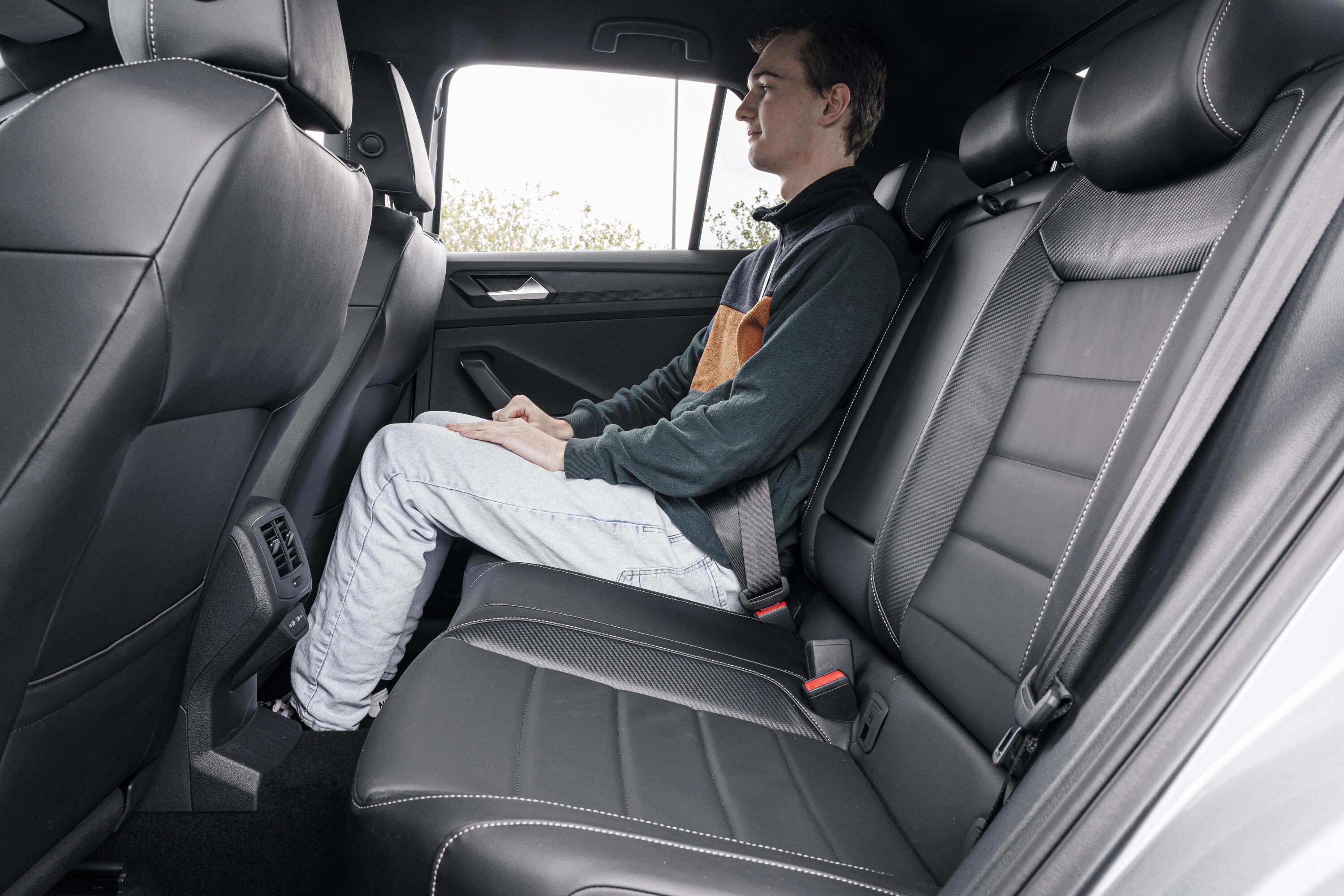
2023 Volkswagen T-Roc 140TSI R-Line boot space
The T-Roc R-Line has a smaller 392-litre boot due to its multi-link rear suspension and all-wheel drive compared with 445 litres on the front-drive CityLife and Style variants that have less expensive, compact torsion-beam rear suspension.
It has 60:40 split-fold rear seats, increasing luggage space to 1237 litres with them stowed.
Mini matchup: Boot space
| MODEL | WHEELBASE | BOOT |
|---|---|---|
| Volkswagen T-Roc AWD | 2596mm | 392L |
| Cupra Formentor | 2680mm | 420L |
| Mazda CX-30 | 2655mm | 317Lu00a0 |
| Toyota Corolla Cross Hybrid AWD | 2640mm | 380L |
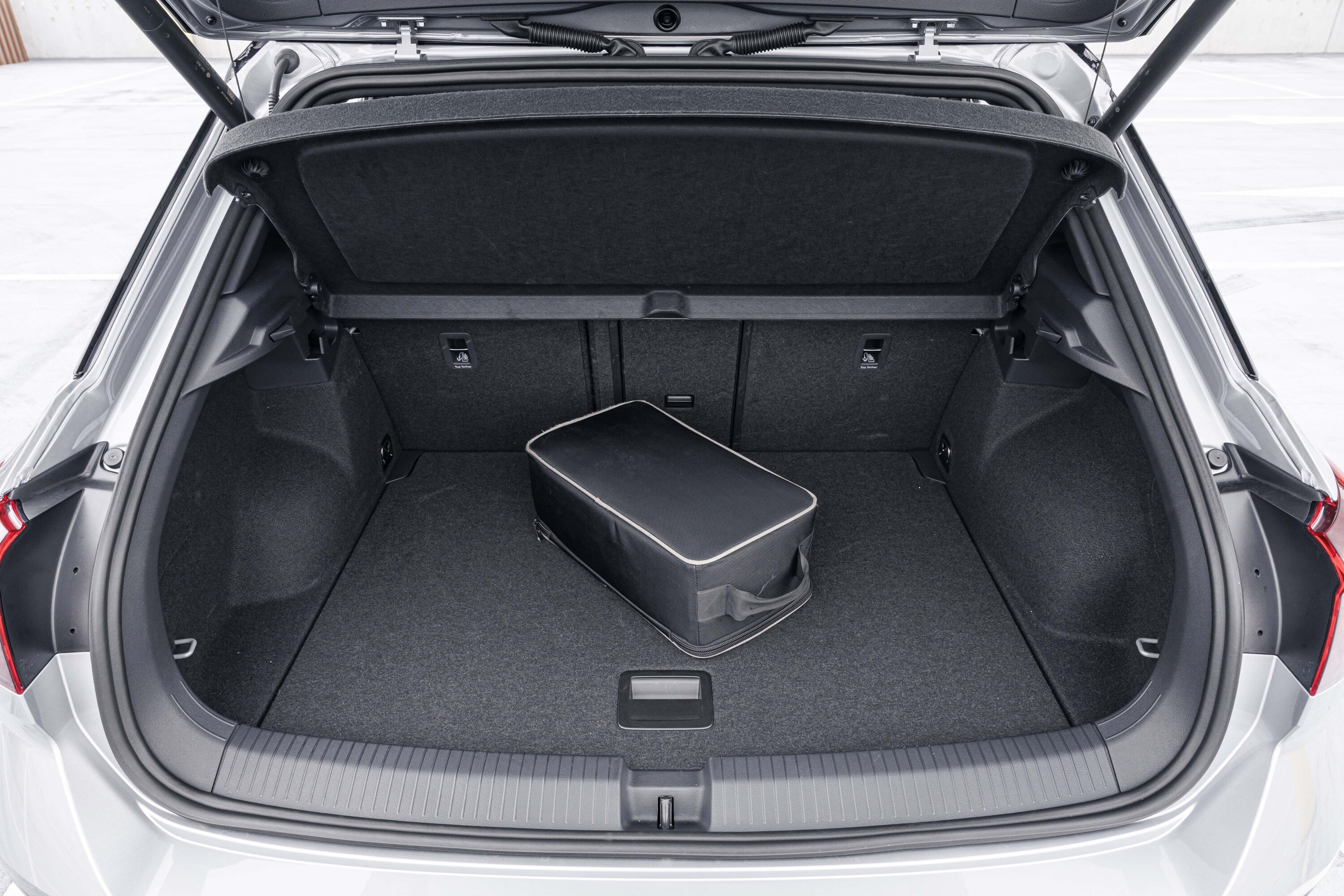
Technology in the cabin
The infotainment display now rises out of the dash rather than being integrated, with an eight-inch screen that retains physical volume and seek dials. Hooray.
While the screen is on the smaller side, its infotainment software is simple to use and feels modern, with up-to-date graphics and processing power. The R has a larger, full-width 9.2-inch screen.
It has wireless Apple CarPlay and Android Auto and a wireless phone charger, which should be a no-brainer combination for all vehicles.
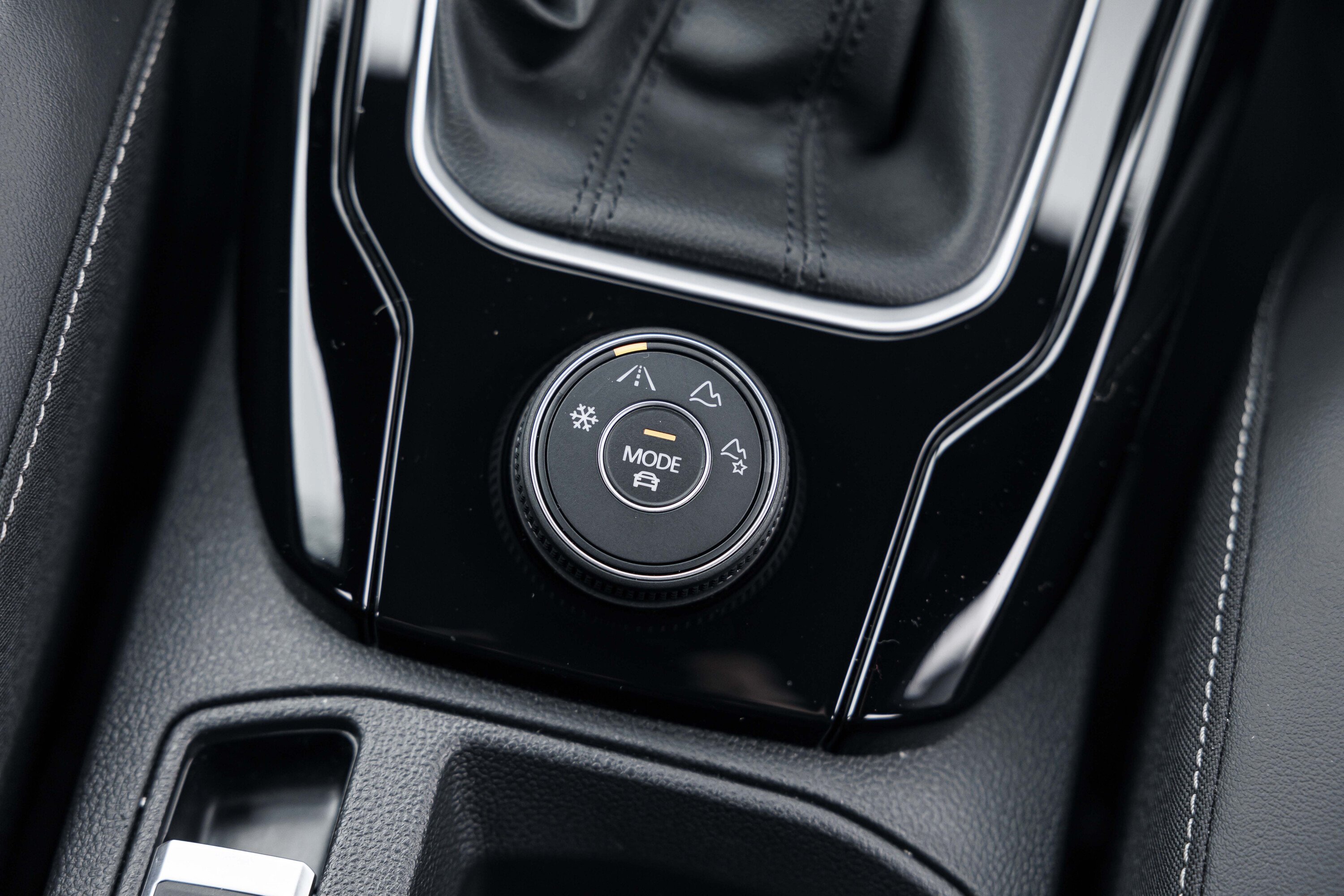
This writer found the wireless connection mostly reliable. Strangely, it dropped out several times when driving through electronic toll sensors on Melbourne’s Citylink. This was also noticed in a Tiguan Allspace, though a web search reveals this might not be unique to Volkswagen vehicles.
A wired connection remains available, unlike some other brands that support wireless connectivity, such as Hyundai and Kia.
The 10.25-inch digital instrument cluster replaces a smaller eight-inch unit in the base CityLife, with crisp graphics and plenty of customisation, including a full-screen map view.
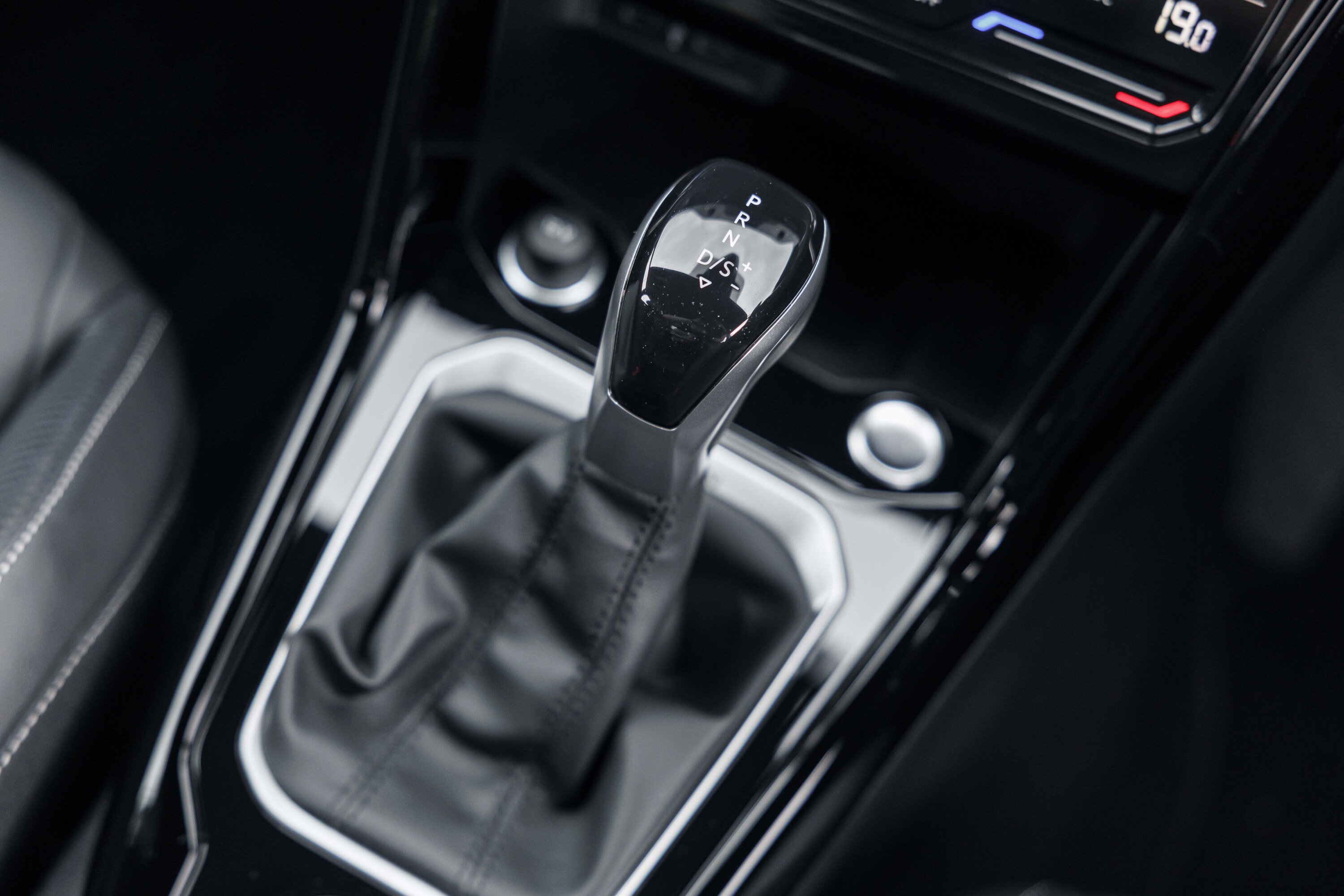
Less impressive are the touch-sensitive haptic steering wheel and climate controls introduced for the facelift. It’s not ideal – a fingerprint magnet and distracting while on the move – and Volkswagen has already said it will revert to physical controls, starting with the next-gen Tiguan due later this year.
The optional Black Style package adds a decent-sounding eight-speaker, 300-watt Beats audio system (including a subwoofer) – replacing the standard, unbranded six-speaker unit – but audiophiles won’t find it as nice as other branded systems.
A 360-degree camera system and head-up display are unavailable on any variant.
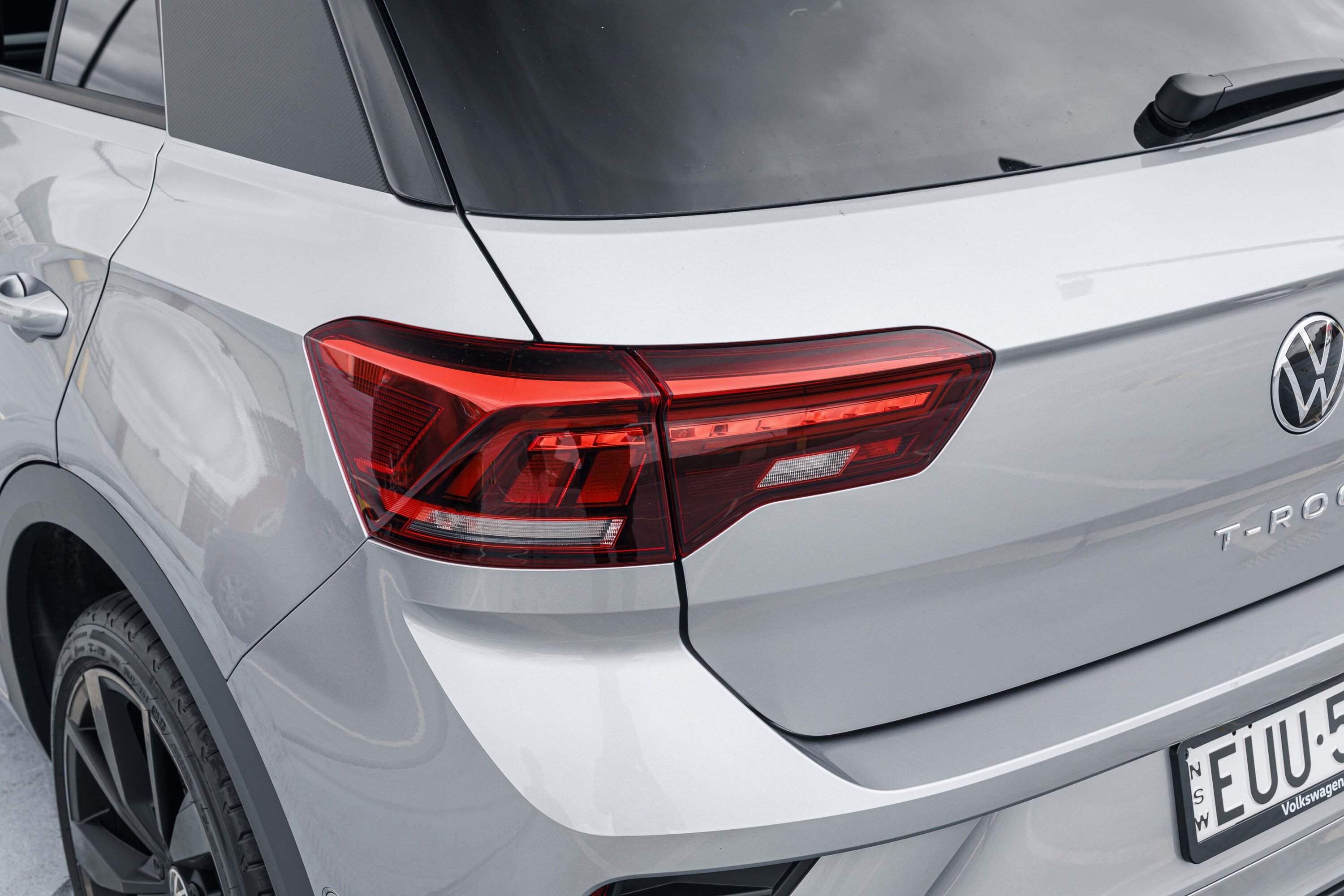
What is it like to drive?
The Volkswagen T-Roc is the clear winner if you’re looking for a fun-to-drive small SUV.
With shared characteristics from the previous-gen Golf 7, the T-Roc hails from an excellent lineage but it feels like a more-sensible, grown-up package.
Under the bonnet, it features the Volkswagen Group’s well-known EA888 2.0-litre turbocharged four-cylinder petrol engine, with a 140kW and 320Nm tune. It is a quiet and smooth powertrain, with noisy hysterics left to the T-Roc R.
It is paired with a seven-speed wet-style dual-clutch automatic transmission, with Volkswagen’s decades of fiddling with DSGs ensuring it remains well-behaved – though there’s still some hesitation and rollback during low-speed manoeuvres on slopes or in reverse.

The T-Roc R-Line has a claimed 7.2-second 0-100km/h sprint time, meaning it’ll accelerate nicely if you’re more assertive with the throttle pedal.
While the ride is firm, it easily manages undulations with only large bumps or potholes unsettling the chassis.
With the Black Pack including adaptive dampers, you can feel the difference when switching into the Sport drive mode, with instantly stiffer suspension and a heavier steering feel, while Comfort mode loosens off for regular driving away from the twisties.
But if you want a T-Roc with the quietest, plushest road manners, the Style is the pick over the R-Line’s firmer suspension set-up. Our test car’s optional 19-inch wheels also elevated road noise.
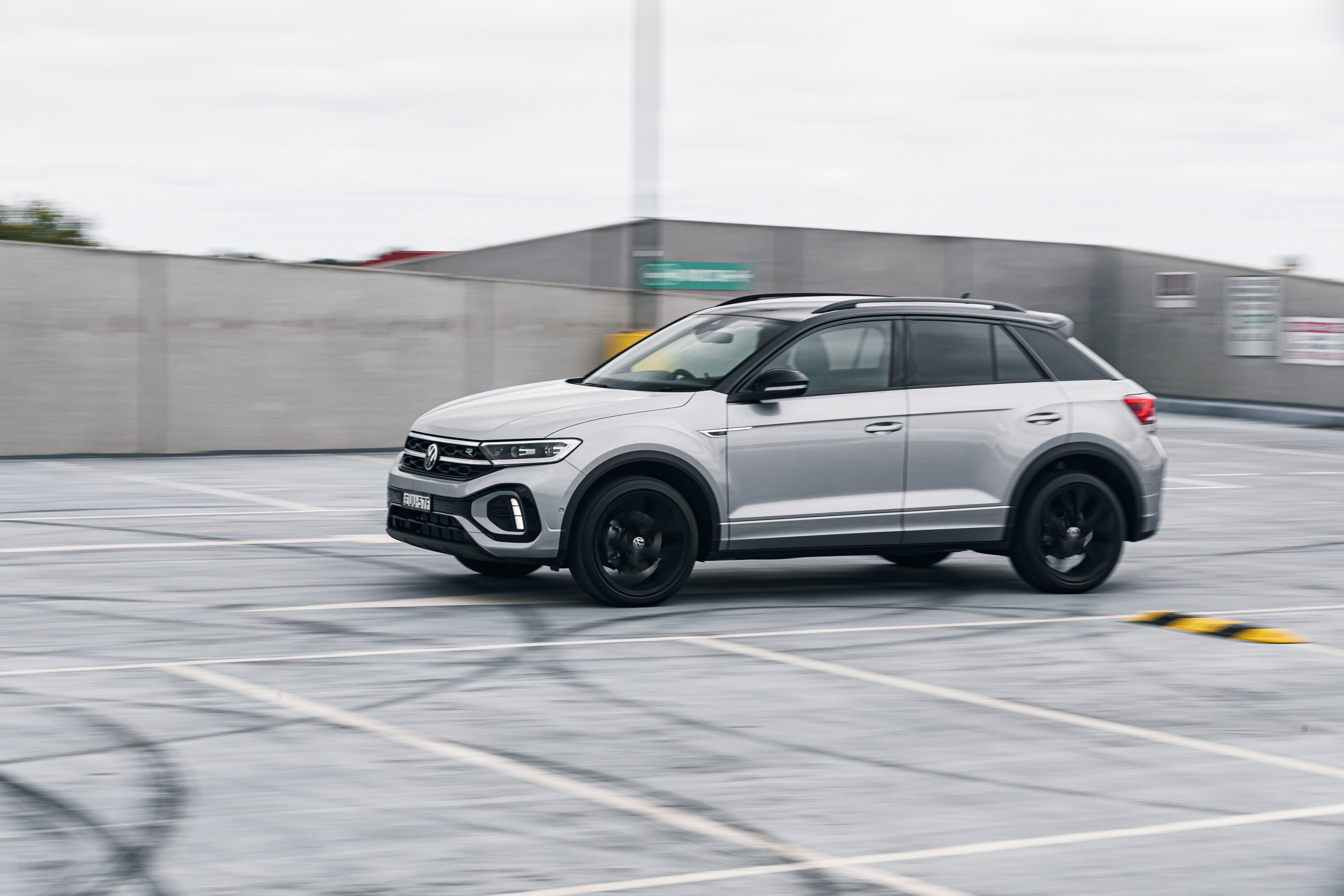
The Haldex all-wheel-drive system ensures the T-Roc remains stable, even in wet weather – and it restricts sending power to the rear wheels unless necessary to save fuel.
Unlike the tighter Mazda CX-30, vision in all directions is hard to fault – it feels like you’re simply driving a high-riding Golf.
The basics
| 2023 Volkswagen T-Roc 140TSI R-Line | |
|---|---|
| Engine | 2.0-litre turbo-petrol inline 4-cyl, dohc, 16v |
| Power | 140kW |
| Torque | 320Nm |
| Transmission | 7-speed dual-clutch |
| Body | 5-door, 5-seat small SUV |
| Fuel consumption (ADR 81/02) | 7.3L/100km |
If any of the terms in this section has left you scratching your head, these articles will help bring you up to speed!
- What is a Powertrain or Drivetrain?
- Power vs torque
- Car suspension explained
- Automatic transmissions (‘gearboxes’) explained
- Chassis control systems explained
- Car vs Ute vs SUV: How the vehicle you buy should guide the way you drive
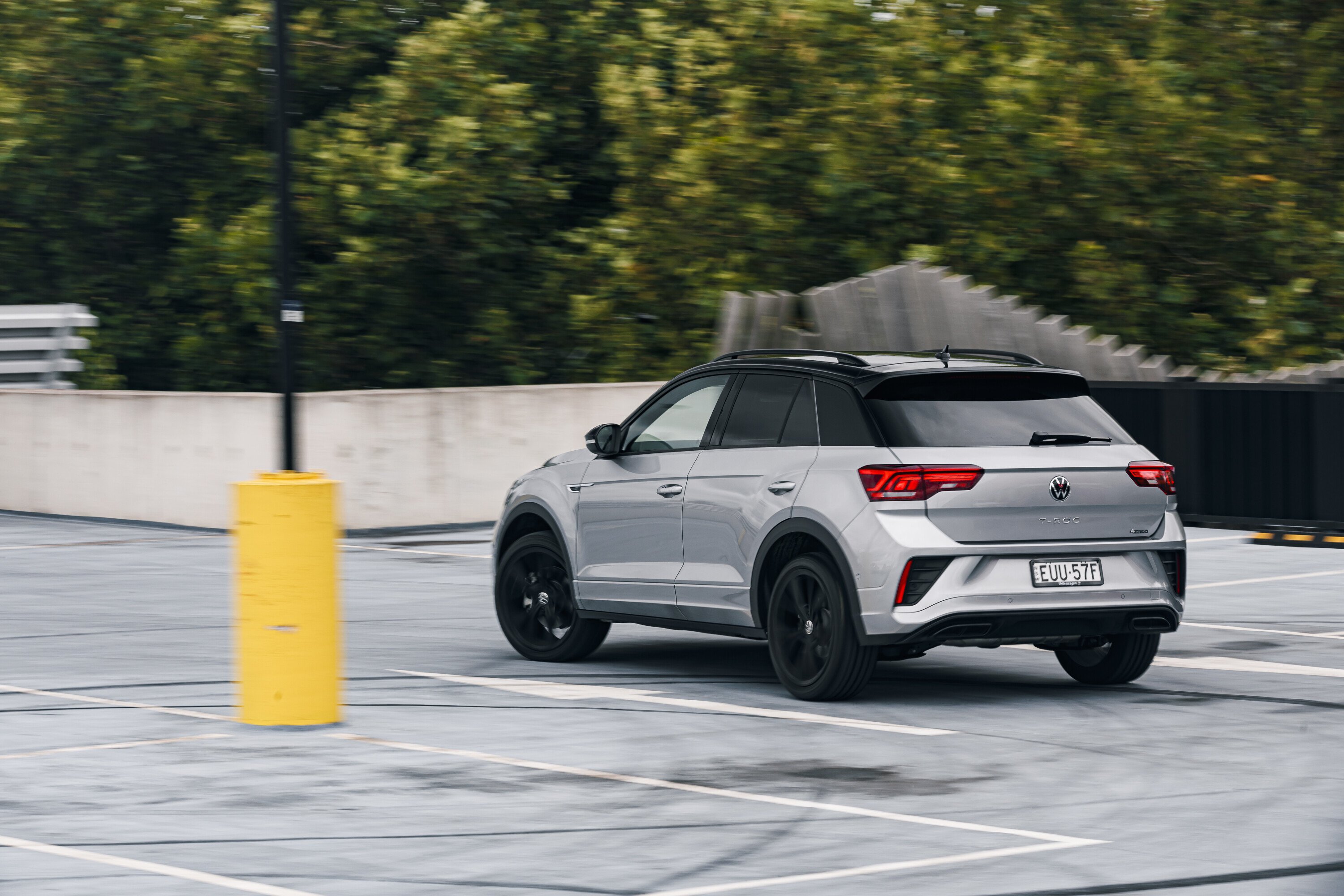
How is it on fuel?
The 2023 Volkswagen T-Roc 140TSI R-Line requires 95 RON premium unleaded or higher.
It has a claimed combined fuel consumption figure of 7.3 litres per 100 kilometres.
At the end of our week-long test, a fuel top-up revealed a real-world consumption figure of 8.3L/100km, which this writer believes is reasonable in an urban environment and with a more spirited weekend drive through excellent roads in Victoria’s Yarra Ranges.
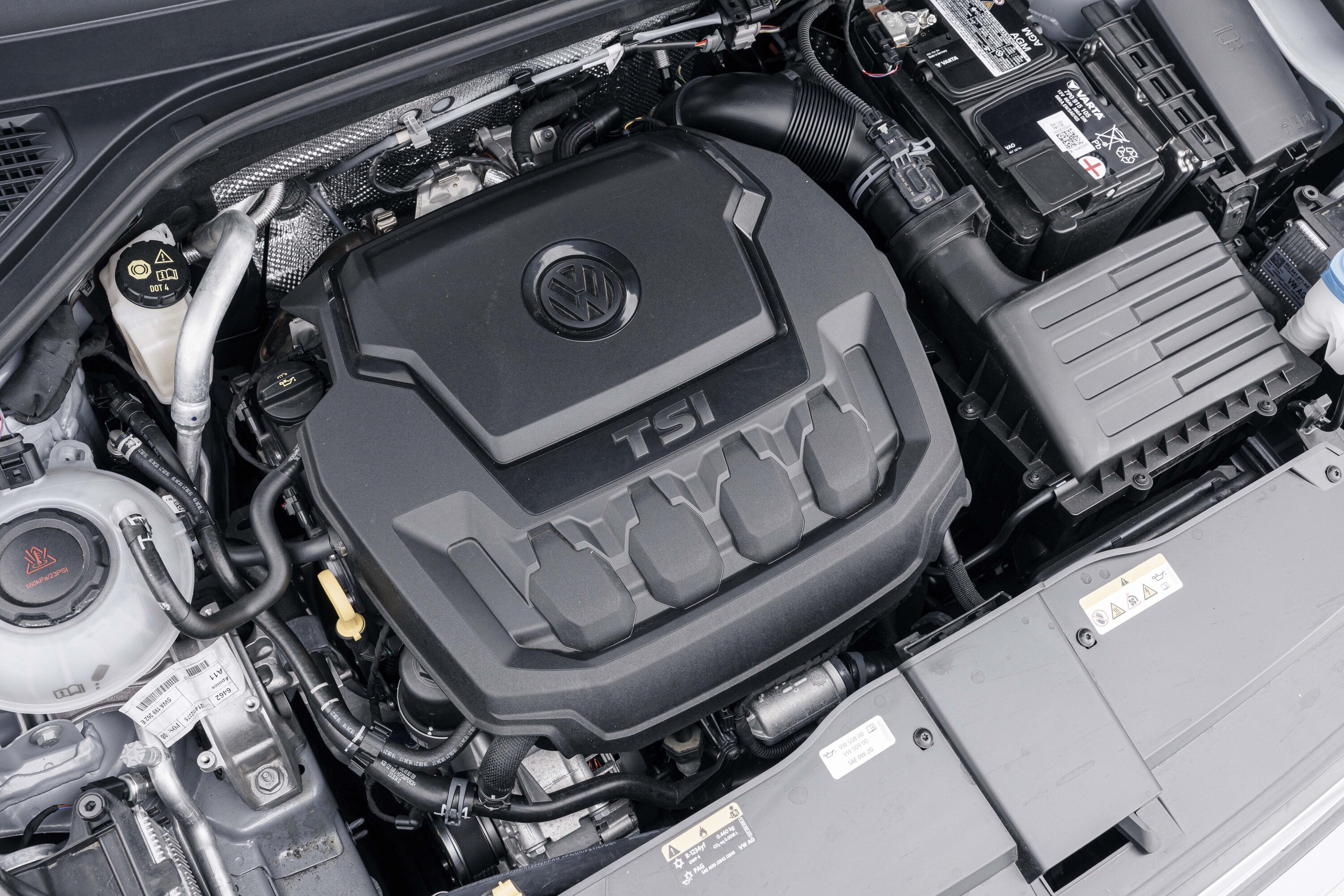
Mini matchup: Fuel consumption
| MODEL | MIN RON | COMBINED FUEL CONSUMPTION |
|---|---|---|
| Volkswagen T-Roc 140TSI R-Line AWD | 95 RON | 7.3L/100km |
| Cupra Formentor V AWD | 95 RON | 7.0L/100km |
| Mazda CX-30 G25 Astina AWD | 91 RON | 6.8L/100km |
| Toyota Corolla Cross Atmos Hybrid AWD | 91 RON | 4.4L/100km |
How safe is it?
The 2023 Volkswagen T-Roc has a five-star ANCAP safety rating based on testing conducted in 2017.
Following ANCAP’s newly-introduced six-year datestamp limit, this rating will expire in December 2023.
Volkswagen has yet to flag any plans to retest the T-Roc, meaning it will soon join the current Passat and Tiguan in lacking a valid rating until new-generation models arrive.
Six airbags – dual front, side and curtain – are fitted, but it lacks a front-centre airbag to prevent head clashes between the driver and front passenger in a side-impact collision, as found in the Toyota Corolla Cross and forthcoming Hyundai Kona.
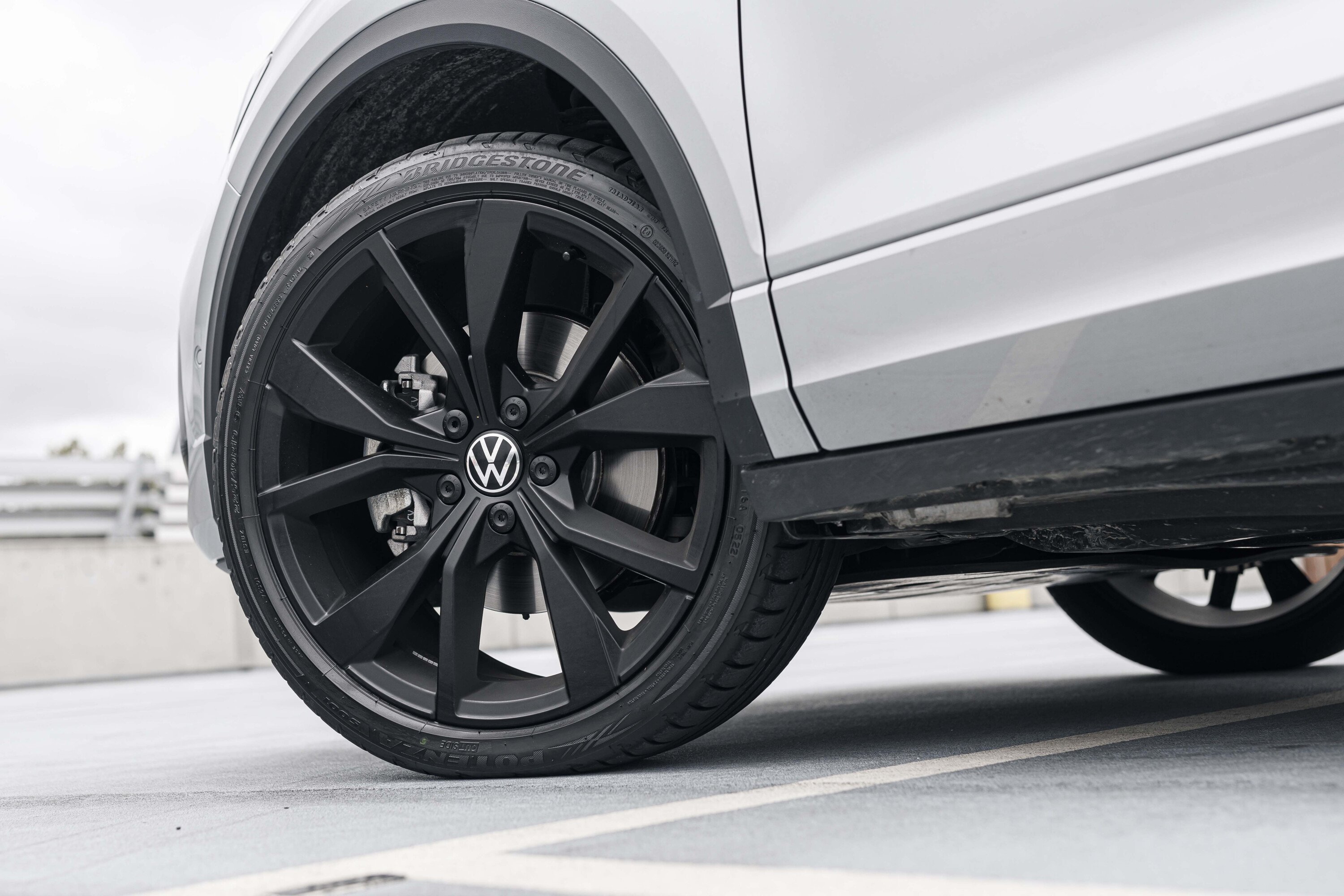
While this isn’t required for a five-star ANCAP safety rating under the latest criteria, several cars – including the four-star Citroën C4 small SUV – have been penalised for lacking a front-centre airbag.
| 2023 Volkswagen T-Roc R-Line: Safety equipment | |
|---|---|
| Six airbags | High-beam assist |
| Anti-lock brakes | Blind-spot alert (late availability) |
| Stability and traction controls | Rear cross-traffic alert (late availability) |
| Autonomous emergency braking (vehicle, pedestrian and low-speed reverse detection) | Driver fatigue alert |
| Lane-keep assist and departure warning | Emergency assist |
| Reverse camera | Multi-collision braking |
As mentioned, some MY23 T-Rocs (excluding the flagship R) exclude blind-spot monitoring, rear cross-traffic alert and proactive occupant protection due to the chip shortage, but this doesn’t affect the five-star ANCAP rating.
Our tester was an MY22 vehicle fitted with these sensors, and examples due to arrive from September 2023 will include blind-spot and rear cross-traffic alerts.
Unfortunately, traffic sign recognition is excluded from local T-Roc examples, despite its availability in other markets. This feature is standard in most of its rivals.
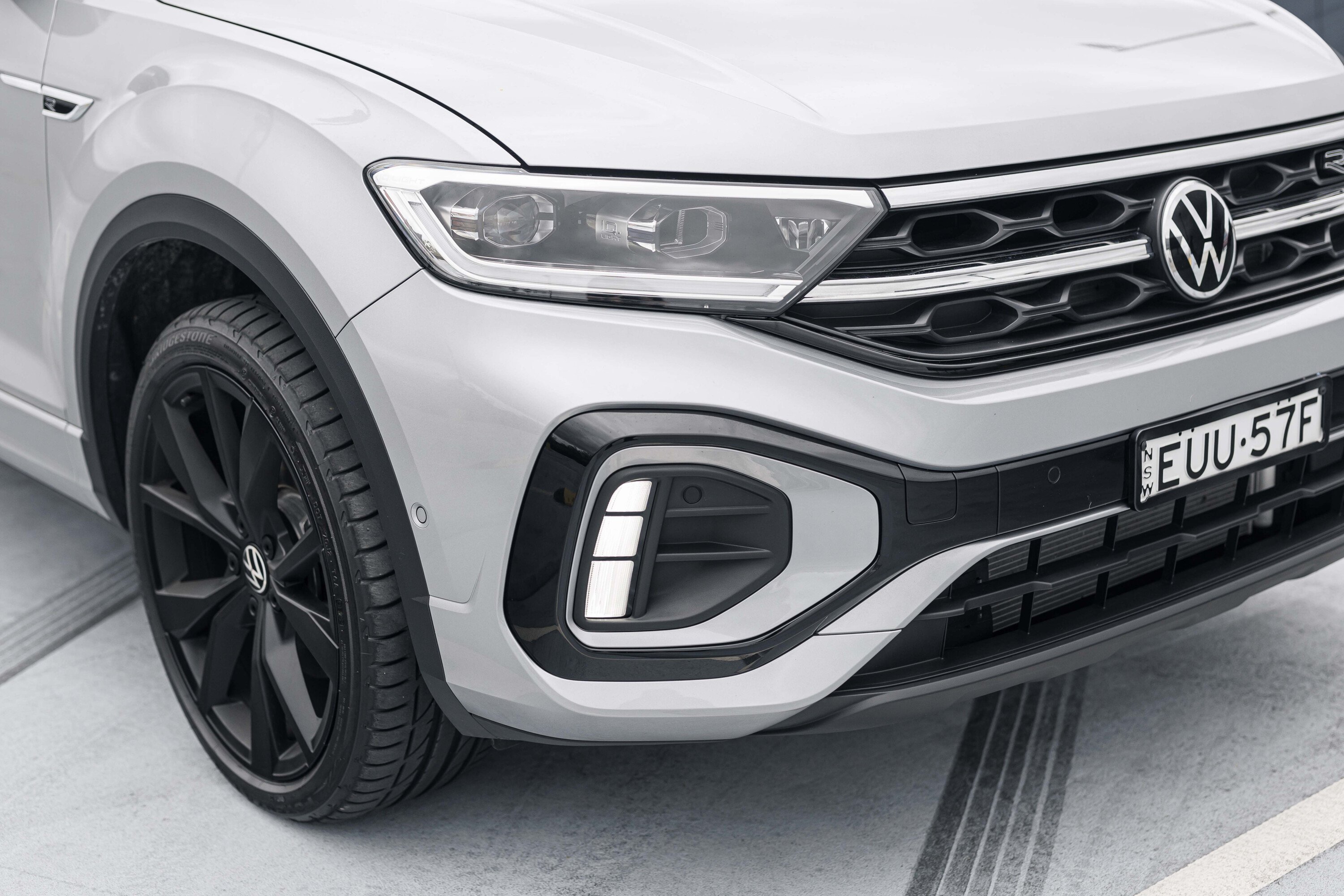
This writer found the lane-keep assist system to work well and, notably, mainly in the background without any frustrating beeping or aggressive steering wheel movement.
VW’s travel assist function – a combination of adaptive cruise control and lane-keep assist – is handy on the freeway to keep the vehicle centred, even around corners.

Warranty and running costs
As per the wider Volkswagen range, the T-Roc is covered by a five-year/unlimited-kilometre warranty.
Roadside assistance is provided for the first 12 months of ownership, with an annual renewal available at each service with an authorised VW dealer.
Maintenance is required every 12 months or 15,000 kilometres, whichever occurs first. A three- or five-year pre-paid service plan is available to purchase at delivery for $1700 or $2850 respectively.
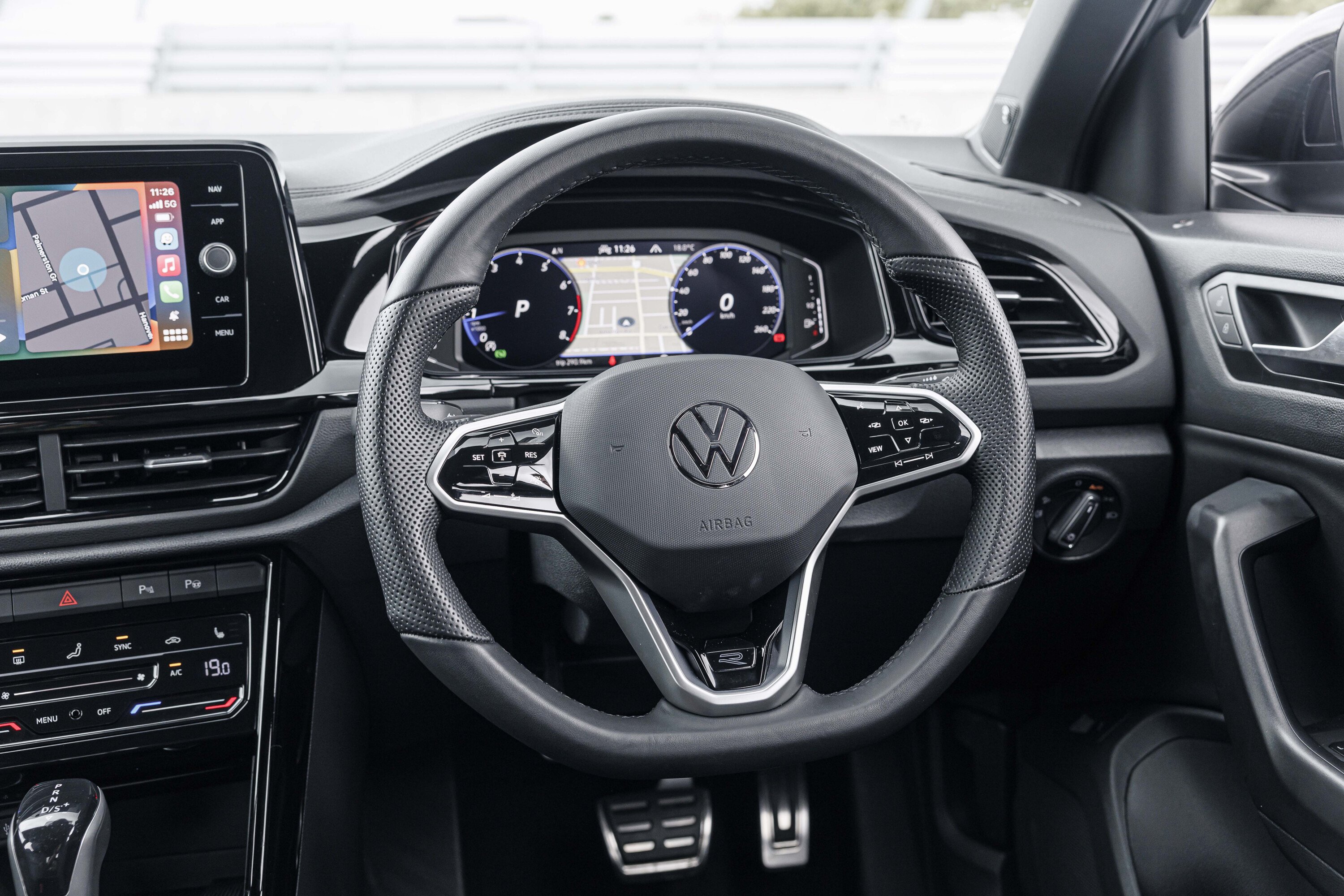
By comparison, Volkswagen’s capped-price program will set you back $3599 over the five-year duration at an average of $720 per service.
This makes the T-Roc the most-expensive mainstream small SUV to service through a dealer over a comparable period. It’s even dearer than an Audi Q2.
All this means it’s worth adding a service pack to your upfront cost if you plan to stick with VW’s dealer network, with a saving of $238 over three years or $749 over five years.
| 2023 Volkswagen T-Roc 140TSI R-Line AWD capped-price servicing | |
|---|---|
| One year/15,000km | $484 |
| Two years/30,000km | $670 |
| Three years/45,000km | $784 |
| Four years/60,000km | $1071 |
| Five years/75,000km | $590 |
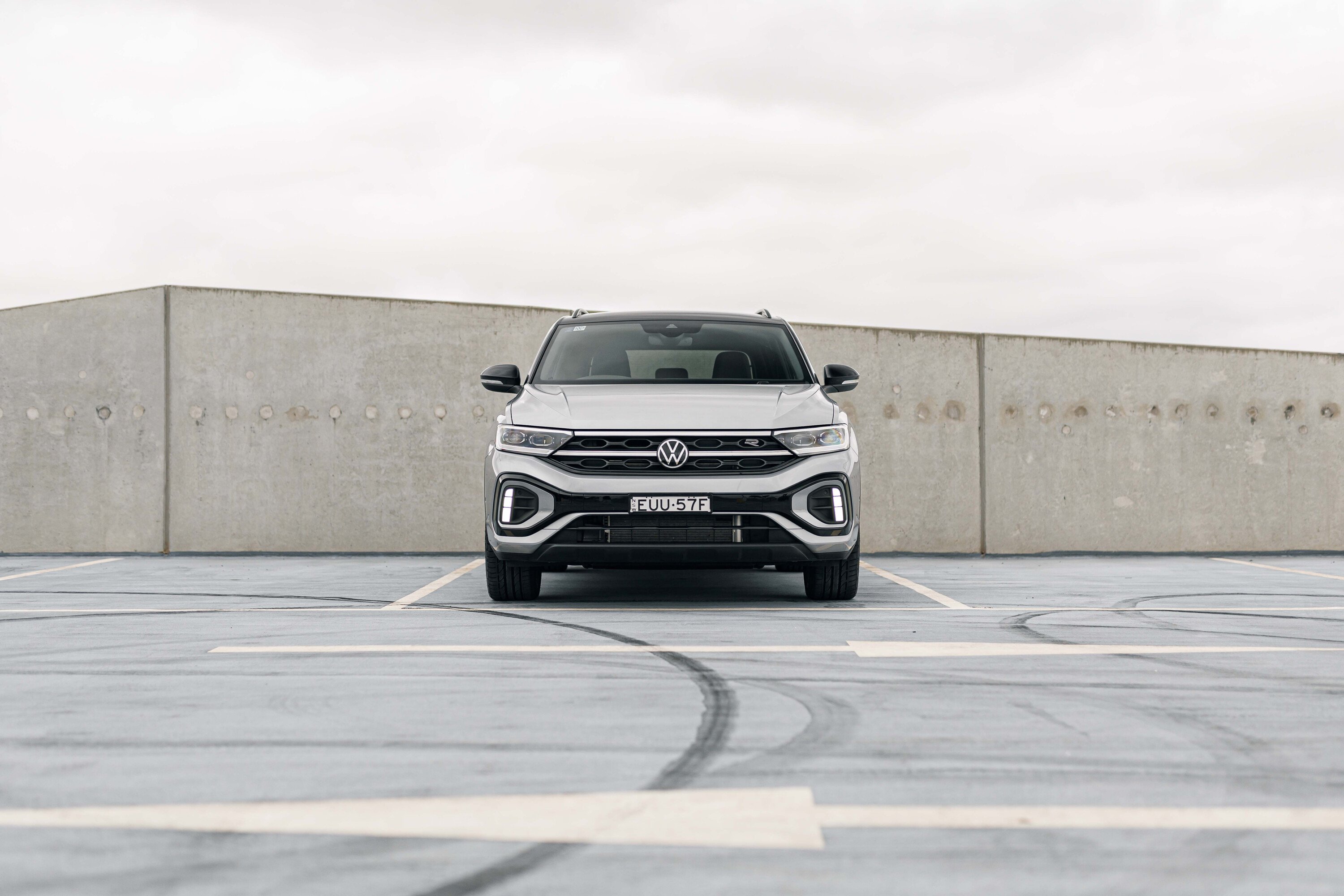
VERDICT
There’s no denying the Volkswagen T-Roc 140TSI R-Line is a refined, stylish and (reasonably) well-specced small SUV.
Select a few option packages, though, and suddenly you’re looking at circa-$60,000 drive-away – or more – for a small Volkswagen. That’s a bit silly.
The sweet spot could be to option the $2900 ‘Black Style package’ to add adaptive dampers, wireless phone connectivity, and the Beats audio system. The stock R-Line is still a fine package, though.
So, the big question is: should you spend the circa-$10,000 premium over its closest rivals? Or identical cash for a luxury small SUV or an upsized turbo-petrol medium SUV – such as the Mazda CX-5 G35, and the Volkswagen Group’s own Skoda Karoq and Golf GTI-derived Cupra Formentor?
If you’re prepared to spend that much dosh, then yes, the T-Roc should be shortlisted – but shop around. There is an overwhelming variety of small and medium SUVs within its price bracket.
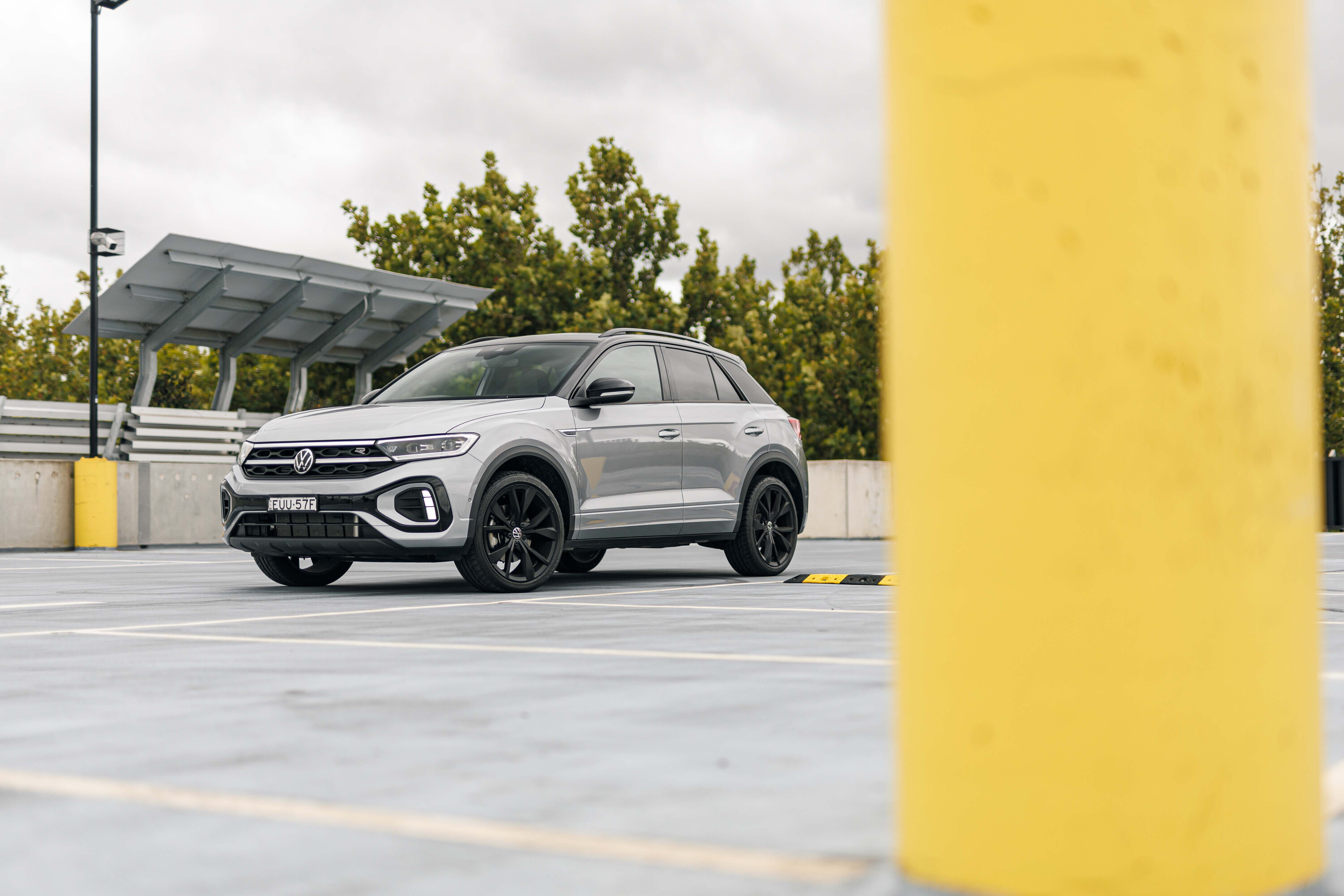
You should also consider the base T-Roc 110TSI Style with a few option packages.
That vehicle still provides an excellent package: a 1.5-litre turbo-petrol, a relaxed traditional eight-speed auto, and a more-compliant ride with smaller wheels. You’ll save a heap of cash, but lose some of the R-Line’s added fun.
And, in case you forgot, the full-fat T-Roc R Grid Edition isn’t much costlier than the R-Line…
| 2023 Volkswagen T-Roc 140TSI R-Line AWD w/ optional Black Pack specifications | ||
|---|---|---|
| Engine | 2.0-litre turbo-petrol four-cylinder | |
| Power | 140kW @ 4200-6000rpm | |
| Torque | 320Nm @ 1450-4200rpm | |
| Transmission | 7-speed dual-clutch automatic | |
| Body | 5-door, 5-seat small SUV | |
| L/W/H | 4236/1819/1573mm | |
| Wheelbase | 2596mm | |
| Boot space | 392L upright / 1237L folded | |
| Weight | 1477kg | |
| Fuel / tank | 95 RON / 50 litres | |
| Fuel use L/100km | 7.3L (claimed) | 8.3L (tested) |
| Suspension | Front: MacPherson struts, anti-roll bar / Rear: multi-link independent | |
| Steering | electric rack-and-pinion; 11.1m | |
| Brakes | Front: ventilated discs / Rear: solid discs | |
| Wheels | 19-inch alloy | |
| Tyres | Bridgestone Potenza S001 | |
| Tyre size & spare | 225/R0R19, space-saver spare | |
Score breakdown
Things we like
- Excellent turbo powertrain
- Top-of-class dynamics
- Improved cabin presentation
Not so much
- Expensive to buy and maintain
- Touch-sensitive haptic controls
- Lacks head-up display, traffic sign recognition
We recommend
-
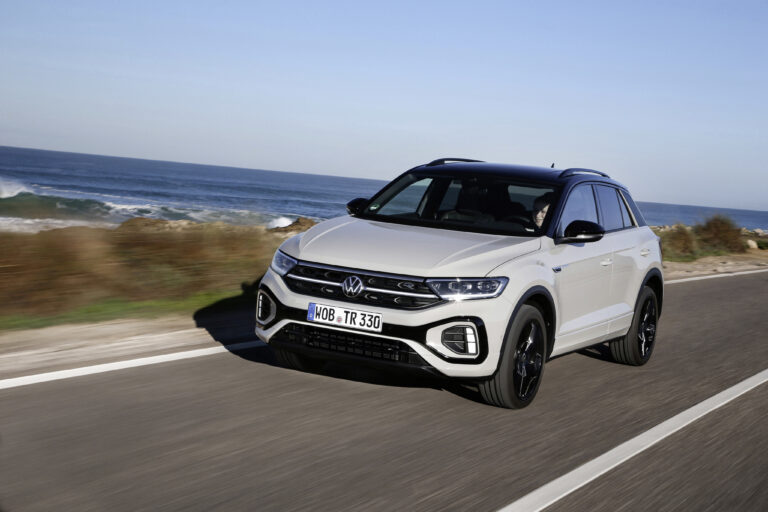 News
News2022 Volkswagen T-Roc: Australian pricing and features confirmed
Volkswagen's popular crossover is set to benefit from a refresh inside and out
-
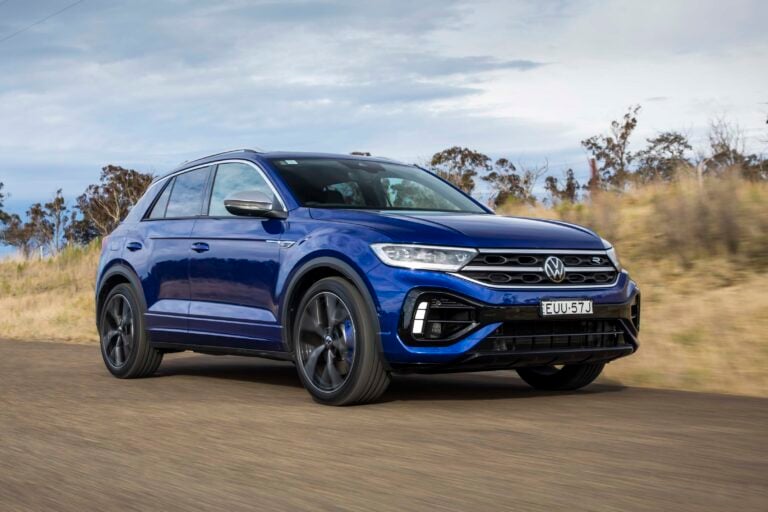 Reviews
Reviews2023 Volkswagen T-Roc R review: Australian first drive
A sub-$60,000 performance car is once again available from Wolfsburg with the belated arrival of the Volkswagen T-Roc R
-
 News
NewsNew car calendar 2026: All the new cars coming to Australia next year
Here’s the WhichCar by Wheels guide to all the new cars that will launch in Australia in 2026. Check back in regularly for updates...


